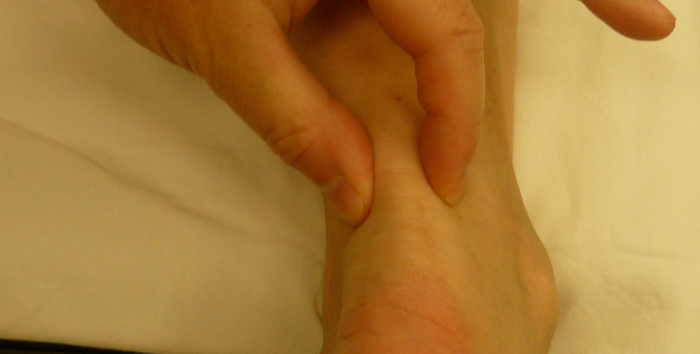Achilles tendonitis, or more accurately Achilles tendinopathy, is an irritation of the large tendon in the back of the ankle.
Achilles tendinopathy is a common overuse injury that tends to occur in running and jumping sports like football and basketball.
Symptoms
Symptoms of Achilles tendinopathy:
- Patients will usually experience pain generally about 5cm above the heel bone. Occasionally pain is in the back of the heal
- Appearance of swelling and tenderness to the touch of the Achilles tendon
Degrees of severity
Achilles tendonopathy can be graded according to how severe it is:
- Mild – pain in the Achilles tendon during activity (such as running or jumping) or shortly after.
- Moderate – the Achilles tendon may appear to swell and become extremely tender to the touch. Pain is accompanied by stiffness, especially at the first step in the morning, or rising after long periods of rest. In some cases, a hard lump (nodule) may form in the tendon.
- Severe – any type of activity that involves weight bearing causes pain of the Achilles tendon. If not managed appropriately the Achilles tendon may further degenerate and rupture (tear).
Common causes
Some of the causes of Achilles tendinopathy include:
- Overuse injury – most common cause of Achilles tendinopathy, this occurs when the tendon is stressed until it develops small tears. Runners and footballers seem to be the most susceptible. People who play sports that involve jumping, such as basketball, are also at increased risk
- Foot problems – some people with flat feet or hyperpronated feet (feet that turn inward while walking) are prone to Achilles tendinopathy
- Footwear – wearing shoes or boots with minimal support while running can increase the risk
- Overweight and obesity – being overweight places more strain on many parts of the body, including the Achilles tendon
Injury Management
Achilles tendinopathy is a condition that responds well if treated appropriately at an early stage. If symptoms are disregarded severe tendon degeneration can develop. In these cases, treatment and rehabilitation can take several months and even up to a year to heal.
The aim of the early treatment is to reduce loading through the Achilles tendon. Load may be reduced by avoiding or limiting activities that may aggravate the condition, such as running. Trying to ‘work through’ the pain without activity modification will only make your injury worse. Pain may initially be reduced by applying ice packs for 15 minutes after activity.
Professional Help
If the pain in your Achilles tendon that you are managing yourself does not improve over a few days, it is best to seek medical advice and consult with one of our Jubilee physiotherapists to get an accurate diagnosis of the injury and suggest the most appropriate treatment plan.
Physiotherapy provides rehabilitation and support
Physiotherapy treatments may include:
- Hands on therapy for damaged tissues
- Exercises to improve mobility of the foot and ankle joints
- Progressive exercises to load and strengthen the Achilles tendon
- Advice on taping to support the arch of the foot or heel supports to take pressure off the Achilles tendon
There have been recent advancements in the understanding of tendinopathy management and rehabilitation. The Physiotherapists at Jubilee have all been educated and trained in the latest research in tendon pathology to help reduce your pain symptoms faster and get you back on the move quicker.
Prevention
Suggestions to reduce your risk of Achilles tendinopathy include:
- Incorporate lower limb stretching into your warm-up and cool-down routines; quadriceps, hamstrings, calves
- Maintain an adequate level of fitness for your sport
- Avoid dramatic increases in sports training in a short period
- Wear good quality supportive shoes appropriate to your sport
- Maintain a normal healthy weight
If you would like further information on the management of Achilles tendinopathy contact one of the physiotherapists at Jubilee Sports Physiotherapy.























